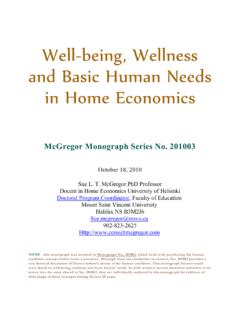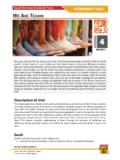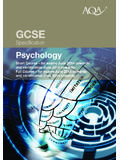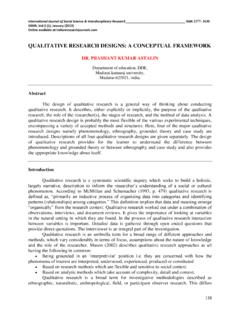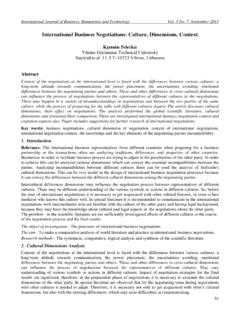Transcription of Urban River Basin Enhancement Methods
1 Urban River Basin Enhancement Methods funded by European Commission 5 th Framework Programme, Key Action 4 City of tomorrow and cultural heritage Existing Urban River Rehabilitation Schemes (Work package 2) Final Report Leibniz Institute of Ecological and Regional Development, Dresden (IOER) Jochen Schanze, Alfred Olfert Dresden University of Technology (TU Dresden) Joachim T. Tourbier, Ines Gersdorf, Thomas Schwager June 2004 i Further partners involved from the URBEM team University of Agricultural Sciences Vienna (BOKU) Hubert Holzmann, Rudolf Faber Portuguese National Civil Engineering Laboratory Joao Rocha University of Ljubljana - Faculty of Civil and Geodetic Engineering Mitja Brilly Javno podjete Vodovod-Kanalizacija (JP VO-KA) Drago Dolenc Cemagref Parcel Breill Centre for Urban Waters UK Cedo Maksimovic Acknowledgement This study has been funded as work package 2 of the URBEM research project by the European Commission under the 5th Framework Programme.
2 The authors furthermore acknowledge Prof. Roger Bettess and Dr. Joao Rocha for their valuable review. ii URBEM Existing Urban River Rehabilitation Schemes IOER & TU Dresden iii Table of Contents 1 Introduction .. 1 Urban River Rehabilitation and the URBEM project .. 1 Investigation of existing Urban River rehabilitation schemes .. 2 Baselines of Urban water rehabilitation .. 3 Urban River rehabilitation in the European 5 2 Approach .. 8 Survey and selection of case studies .. 8 Standardised enquiry .. 11 3 Characterisation of the case studies .. 13 Brief description of each case study .. 14 Comparison of general characteristics .. 21 4 Planning and implementation process .. 30 Initiation of Urban River rehabilitation projects .. 30 Site selection .. 32 Aspects of project management .. 37 Site management and maintenance .. 43 5 Rehabilitation techniques.
3 45 Techniques to improve hydrology and 46 Techniques to improve stream morphology and connectivity .. 47 Techniques to improve water quality .. 53 Techniques to improve biodiversity .. 55 Techniques to improve features of public health and 56 6 Impacts of River rehabilitation projects .. 59 Ecological impacts .. 60 Social and aesthetic impacts .. 66 7 Aesthetic evaluation Methods .. 76 State of the art .. 76 Aspects of aesthetics considered in Urban River Enhancement .. 77 Applied aesthetic evaluation Methods .. 79 URBEM Existing Urban River Rehabilitation Schemes IOER & TU Dresden iv 8 Social appraisal and stakeholder involvement .. 84 Legal requirements for public participation .. 84 Stakeholders .. 85 Informing 88 Involving stakeholders in the process .. 91 Stewardship and advocacy .. 96 Monitoring social impact .. 98 9 Performance control and indicators of 100 Definitions.
4 100 Performance control as practised .. 102 Towards indicators of success for Urban River rehabilitation .. 108 10 110 11 113 12 Acknowledgements for contributions to the case studies .. 120 13 Annexes .. 1 Annex 1 Data enquiry form ..1 Annex 2 Description of techniques .. 1 URBEM Existing Urban River Rehabilitation Schemes IOER & TU Dresden v List of Figures Figure 1: Objectives of Urban River rehabilitation projects 23 Figure 2: Objectives of ecological improvement in Urban rehabilitation projects 24 Figure 3: Urban pressures and pressures in case study areas 24 Figure 4: Width of rehabilitated water courses (classification by Huet 1949) 25 Figure 5: Lengths of rehabilitated sections 26 Figure 6: Length of rehabilitated sections of water courses and overall size of affected area 26 Figure 7: Total costs of Urban rehabilitation projects 27 Figure 8: Total costs of Urban River rehabilitation projects 28 Figure 9: Correlation of total project costs and the length of the rehabilitated section 28 Figure 10.
5 Costs per meter of Urban River rehabilitation projects 29 Figure 11: Initiators of Urban River rehabilitation projects 31 Figure 12: Funding sources for Urban River rehabilitation projects 38 Figure 13: Time frame for realisation of Urban River rehabilitation projects 42 Figure 14: Time line of planning and implementation of Urban River rehabilitation projects 42 Figure 15: Measures to improve stream hydrology and hydrodynamics 46 Figure 16: Measures to improve instream morphology 49 Figure 17: Measures to re-establish and to integrate flood plains 51 Figure 18: Measures improving continuity 52 Figure 19: Measures to improve water quality 54 Figure 20: Measures directly improving biodiversity 56 Figure 21: Measures to improve safety features 57 Figure 22: Biological conditions of Urban waters before and after rehabilitation 60 Figure 23: Impact of Urban River rehabilitation schemes on fish fauna 61 Figure 24: Impact of Urban River rehabilitation schemes on benthic invertebrate fauna 61 Figure 25: Impact of Urban River rehabilitation schemes on benthic macrophytes and phytobenthos 62 URBEM Existing Urban River Rehabilitation Schemes IOER & TU Dresden vi Figure 26: Hydromorphological conditions of Urban waters before and after rehabilitation 63 Figure 27: Impact of Urban River rehabilitation schemes on morphological conditions 63 Figure 28: Impact of Urban River rehabilitation schemes on River continuity 64 Figure 29: Impact of Urban River rehabilitation schemes on hydrological regime 64 Figure 30: Conditions of chemical and physico-chemical components of Urban waters before and after rehabilitation 65 Figure 31.
6 Impact of Urban River rehabilitation schemes on general conditions of physico-chemical components 66 Figure 32: Active recreation uses in Urban River rehabilitation areas before and after rehabilitation 67 Figure 33: Use of Urban River rehabilitation areas for not water related sports 67 Figure 34: Use of Urban River rehabilitation areas for playful recreation 67 Figure 35: Passive recreation uses in Urban River rehabilitation areas before and after rehabilitation 68 Figure 36: Educational, cultural and commercial offers before and after rehabilitation 68 Figure 37: Environmental education in Urban River rehabilitation areas 69 Figure 38: Historical and cultural education in Urban River rehabilitation areas 69 Figure 39: Visual and spatial experience along Urban River rehabilitation sections before and after rehabilitation 70 Figure 40: Presence of focal points in Urban River rehabilitation areas 70 Figure 41: Visual aversion experiences in Urban River rehabilitation areas 71 Figure 42: Overall acceptance of Urban River rehabilitation sites before and after rehabilitation 71 Figure 43: Frequency by local population in Urban River rehabilitation areas 72 Figure 44: Frequency by school classes in Urban River rehabilitation areas 72 Figure 45: Aspects of economic wellbeing in areas adjacent to Urban River rehabilitation sites before and after rehabilitation 73 Figure 46: Impact of Urban River rehabilitation schemes on the visitor frequency in the adjacent area 73 URBEM Existing Urban River Rehabilitation Schemes IOER & TU Dresden vii Figure 47.
7 Impact of Urban River rehabilitation schemes on property value in the adjacent area 74 Figure 48: Impact of Urban River rehabilitation schemes on housing costs in the adjacent area 74 Figure 49: The Information pyramid of an indicator system 101 URBEM Existing Urban River Rehabilitation Schemes IOER & TU Dresden viii List of Tables Table 1: Examples of Urban rehabilitation programs in Europe emphasising the rehabilitation of Urban waters 6 Table 2: Survey of schemes considered for the choice of case studies (selection) 9 Table 3: Cases studies chosen for the in depth investigation 13 Table 4: Distribution of case studies in European eco-regions according the WFD 22 Table 5: Initiation of Urban River rehabilitation projects 30 Table 6: Selection of sites for Urban River rehabilitation 33 Table 7: Methods and aspects of rehabilitation potential assessment found in case studies 34 Table 8: Aspects of practicability and enforceability in Urban River rehabilitation projects 34 Table 9: Sources used for financing Urban River rehabilitation schemes 38 Table 10: Techniques used for improving hydrology and hydrodynamics 46 Table 11: Techniques used for improving stream morphology and connectivity 48 Table 12: Techniques used for improving water quality 53 Table 13: Techniques used for improving aquatic and riparian flora and fauna 55 Table 14: Techniques incorporating features to improve public health and safety 57 Table 15: Consideration of aesthetics and usability 78 Table 16: Aesthetic evaluation Methods used in the case studies 79 Table 17.
8 Legal requirement for public participation in Urban River rehabilitation projects 85 Table 18: Involved stakeholders 85 Table 19: Ways of informing stakeholders 88 Table 20: Citizen involvement 91 Table 21: Advocacy and stewardship 96 URBEM Existing Urban River Rehabilitation Schemes IOER & TU Dresden 1 1 Introduction Urban River Rehabilitation and the URBEM project cultural requirements and natural properties meet directly at riversides in Urban areas. Sustainable development needs knowledge of the interrelations between Urban conditions and the state of waters as well as instruments and techniques for their management. This is especially true for the industrial nations of Europe where much of the population live in cities and towns. Impacts on waters of sewage discharge, the high dynamics of storm water runoff, limited groundwater recharge, fragmentation, canalisation, culverting and others cause serious effects on aquatic organisms and the whole water ecosystems.
9 In return they lead to manifold influences on Urban life like decrease of water supply, risk to public health due to chemical and bacteriological water pollution, threats by flooding or loss of quality of Urban open spaces by reduced aesthetic value. Aesthetic value also represents an important factor for the economic prosperity and social life in the riverine districts. To maintain the potentials for Urban development in this areas degradation of Urban waters should be avoided. Therefore, Urban pressures on waters have to be minimised. Beside the ongoing reduction of the sewage water discharge the development of Urban waters need to be seen as a comprehensive task (Schanze 2002a,b). In contrast to historical River modifications for various purposes of utilisation, current and future generations require an Enhancement of the sustainability of European Urban waters.
10 This altered perspective is especially exemplified by the European Water Framework Directive (WFD). As a main instrument of the European Water Policy it has been introduced to avoid further deterioration of and, if possible, to improve all kind of waters. For surface waters it determines a good surface water status (Article 4/1/ii). As far as morphological limitations cannot be removed the WFD gives cities an opportunity to define heavily modified water bodies . In this case as a less stringent standard, good ecological potential , needs to be reached (Article 4/1/iii). However, cities should not feel disengaged from improving the qualities of their waters. At least good surface water chemical status will be required for heavily modified and artificial water bodies, too. It can be expected that most advanced techniques utilized in some of the existing installations become best practicable technology in water resource management.


